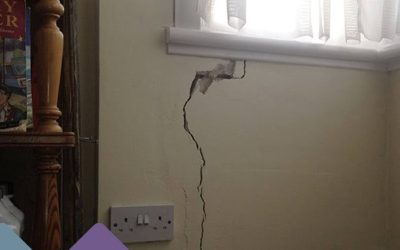Hello and welcome to our property surveying blog post, In today’s blog we will be taking a look at Defect Analysis reports and some of the common defects that we have come across over the years at Stokemont.
What is a defect analysis report?
A defect analysis report is a thorough investigation into a particular defect that will outline the potential causes of the defect and give clear, objective advice on how to rectify the problem.
How long will a defect analysis report take?
The amount of time that a surveyor will stay on-site during an inspection will vary depending on the nature and seriousness of the defect.
This will vary from one hour up to three if it is felt necessary but unless under exceptional circumstances it would be unlikely for the inspection to go beyond the three-hour mark.
During the inspection the surveyor is generally going to start by asking questions in order to get some history of the issue, then they will conduct a full comprehensive inspection of the defect and the property to establish the cause and will advise on how to best resolve the issue.
When might you need a defect analysis report?
Commonly we find that when our clients have had an RICS Homebuyer report that has outlined defects they will then follow suit with a defect analysis report as the defect outlined may have required further investigation.
Other times some one may have a recurring problem that they have tried to remedy over and over again but have been unable to do so, and are now looking to instruct a Surveyor to give them an insight into the issue so they can get the correct remedy to the problem.
Some of the common issues that we have seen throughout the years
Structural Movement
This can be a fair common cause of defects as most of the properties that have been constructed throughout London where built turn of the 19th century, little consideration was given to the type of substrate that the property was being constructed on and to the necessary depth of the foundations that are built upon.
Damp
Damp is probably the most common defect that is found within properties in the uk and can have a number of causes, from roofing defects, defects to the brick work or cladding, burst pipes, etc.
So even though it is a fairy common defect as it can have a number of differing cause it can be a fairly tricky one to get to the root cause of the issue.
Roofing Defects
Roofing defects are a common defect that you are likely to encounter across properties all over the world, with this likely to cause further issues if not rectified.
As if there is a roofing defect this could lead to elements being able to penetrate into the property which can cause a plethora of issues from dampness to timber rot.
What to do when you receive your defect analysis report?
Once you have the report in hand you can then present that to your contractors who will be able to act on the suggested remedy that has been outlined by the surveyor, the surveyor is even able to speak to the contractor on your behalf to ensure that everything is smoothly communicated clearly across to them.
I hope this has given you further insight in to what is entailed in a defect analysis report, if you have any questions in relation to today’s blog post or any of the other services that we offer here at Stokemont. Please do not hesitate to get in touch today.




